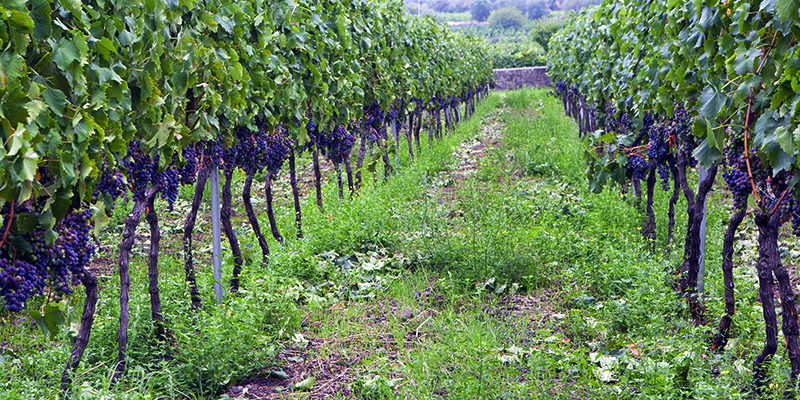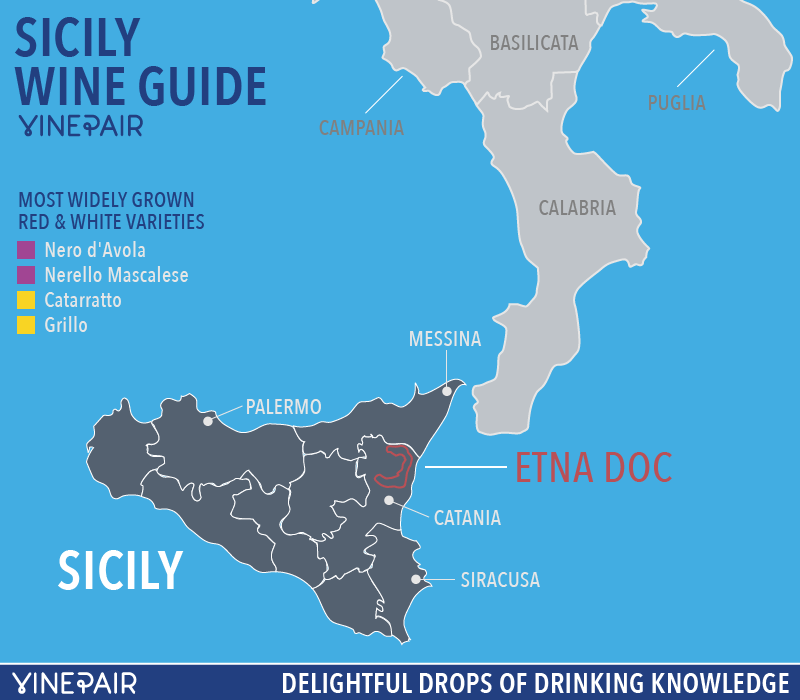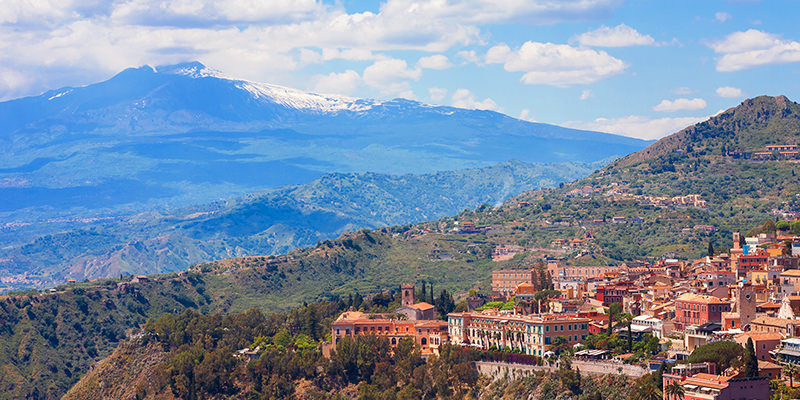In the opening scene of the Godfather Part II (1974) we see a scrub brush desert-like landscape as a funeral march enters stage left. Somber music emanates from the procession as the funeral winds its way through piles of rocks, long fallen from yonder hill. It’s a stark, desolate landscape and for many, this is their first glimpse of Sicily.
Although it’s been said that this geography is constant across the island, it isn’t. There are actually many green patches in between (just check out the running slide show on this site), which is where the wine is made.
The largest island in the Mediterranean, Sicily has been occupied by many cultures throughout history, with each group bringing their own unique architecture and practices for either good or harm. These cultures also brought with them their native crops, in hopes of cultivating a piece of their homeland on the island. The Greeks brought olives and grapes. The Romans brought wheat (lot’s of it!). The Moors brought sugarcane, along with lemons and oranges, as well as pistachios, and implemented a new technique called irrigation. With all this influence, Sicily has become an agricultural phenomenon. And for the native grapes of this region, the resulting wine and the winemakers who coax them into existence, it is a veritable Dionysian given gift.
We’re currently experiencing a boom of Sicilian wines on the American market, making this the ideal time to celebrate these wines from a land of hilly and mountainous terrain, excellent elevation and hillside vineyards with wonderful sun exposure. The wines of Sicily have a true personality all their own and are often quite affordable. So let’s get into it!
There are twenty three DOC zones on this island and one DOCG. That’s a lot for one volcanic outcropping. Many of those wines don’t make it over to the U.S., but the ones that do are a great example of what Sicilia has to offer. Here are the wines to get you started:
Nero D’Avola
Nero D’Avola, Sicily’s pride and joy, is the most widely planted red wine grape on the island. Thought to have been brought over from Calabria – the grape is also called Calabrese by some winemakers – wines from this grape can take on many forms depending on where the grape is grown. Nero D’Avola always has a nice, deep color and can have a significant tannin structure. Some of the wines can be vibrant with cherry and plum fruit while others (usually the more expensive examples) can lean more toward baker’s chocolate.
But for our purposes and wallets, the lively, youthful and less expensive examples are the crowd-pleasers. Ranging from around $8-$15 a bottle, these wines will pair well with any dish you serve, whether it be grilled meats, salami and cheese plates or even filleted fish dishes with a bit of cream sauce. It also pairs well with rooftop parties and is great with a slight chill for that picnic in the park. You can’t go wrong with this wine that’s often labeled under the Sicilia DOC, a zone that covers the entire island.

Catarratto, Grillo and Inzolia–Oh My!
Catarratto is the most widely planted white wine grape in Sicily and the second most planted in all of Italy after Sangiovese. Along with Grillo and Inzolia, these three have traditionally been blending partners, and they’re the source of some of the best low priced white wine from Italy.
And while the blend is delicious, for about a decade now the winemakers of Sicily have been isolating Inzolia and Grillo and making single varietal wines from these grapes, letting them shine. Nowadays it’s not hard to find a bottle of clean aromatic Inzolia full of minerality and nutty, citrus and floral notes starting at around $8 and peaking in the $15 range. We are seeing more Grillo as well in the same price range with similar notes in addition to crisp green apple on the nose and palate. Grillo is a bit lighter than Inzolia, which has a nice soft weight. As for Catarratto, it is still often being used for blending in small amounts with the new Sicilian fave Chardonnay.
Etna
Just inland from the northeastern coast is towering Mount Etna, the tallest active volcano on the European continent. On the Eastern slope of this still smoldering giant are vineyards growing in dark, rich volcanic soil, making beautifully elegant wines from three prominent grapes, Nerello Mascalese, Nerello Cappuccio and the amazing high-toned Carricante. The first two are often blended together with a minimum of 80% Nerello Mascalese and a maximum of 20% Nerello Cappuccio. The result is a wine often compared to the characteristics of great Burgundy: bright ruby red in color with almost perfect acidity wafting in with mashed berries and smoky notes.
For the whites of Etna, Carricante is the star, making up at least 60% of the blend but many winemakers use 100% of the grape. If a wine can be deep and soulful while still shining through with bracing acidity, this is the wine. The orange, lemon and grapefruit notes play well with the savory hues of Anise seed and honey, making this wine ideal with a meal. These wines are a bit pricer across the board than other whites from Sicily, ranging from $15-$30. Though they have a higher price tag, they are definitely worth the coin.
I’ll leave you here as you go off and enjoy the wonderful wines of Sicily. I’ll imagine you in the wine shop, walking toward the Italian section in slow motion, with the sweet strings of the Godfather Love Theme as your soundtrack, embraced by a soft vignette. Ci Vediamo a presto!

![An Introduction To The Wines Of Sicily [WITH MAP] An Introduction To The Wines Of Sicily [WITH MAP]](https://vinepair.com/wp-content/themes/miladys/src/assets/images/article-card-small.png)
